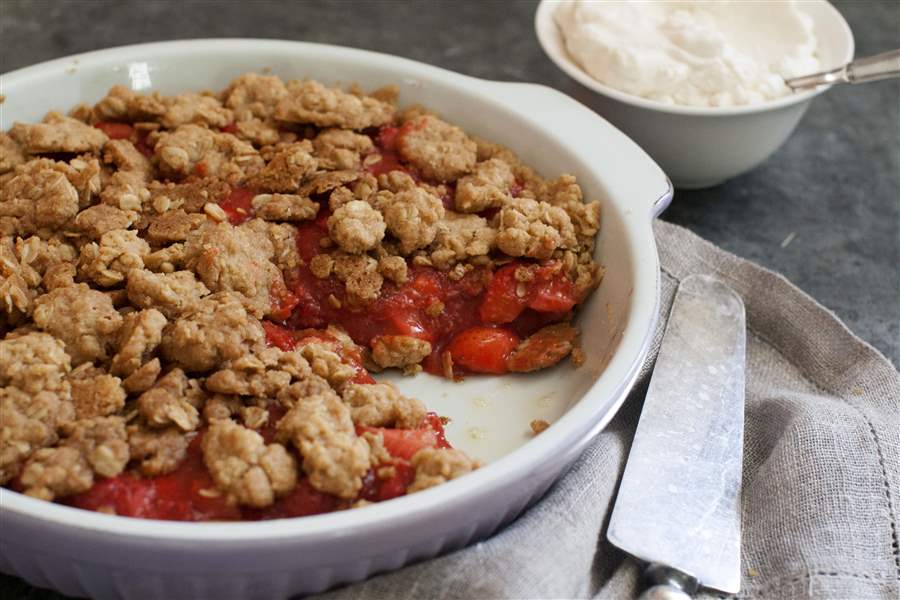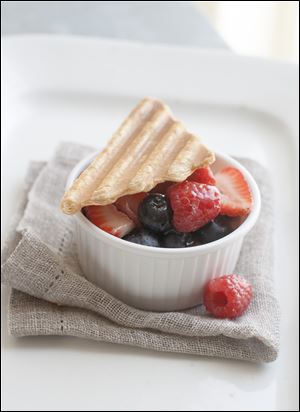
July Fourth celebrations didn’t always include pie
Recipes for strawberry streusel pie and berry-cream pot pies
6/30/2014
Strawberry Streusel Pie.
ASSOCIATED PRESS

Strawberry Streusel Pie.
Apple pie may be as American as the Fourth of July, but it probably wasn’t on the table when the holiday first began.
“There wouldn’t have been a whole lot of apples around this time of year,” says Mary Thompson, research historian at Mount Vernon, the plantation estate of George Washington. “They would have eaten them all from last year, and this year’s crop wouldn’t have come in yet.”
From blueberry to strawberry to the pie that combines them to represent the flag, pie is associated with Independence Day. But back in the 18th and 19th centuries, when the holiday was still new, pies weren’t celebratory at all. They were simply a way of life.
“These were not treats,” says Amanda Moniz, an executive of the American Historical Association and author of the blog History’s Just Desserts. ‘‘They were convenience foods and they were frugal food.”
Pies served multiple functions for early Americans. They were the original street food, Moniz says, a handy slice serving as plate, utensil and sustenance all at once. Crust was often made of coarse ingredients such as rye and suet, she says, and wasn’t meant to be eaten. It was simply a vehicle for the nutrition inside.
“Centuries ago this would have been fast food,” Moniz says. “People would have been walking through the street hawking pie. If you didn’t have your own cooking facility you could just buy a slice of pie the way you buy a hot dog from a cart today.”
But not all pies had disposable crusts. Hannah Glasse, author of the 18th century equivalent of Joy of Cooking, had several recipes for crust, as did Amelia Simmons, who wrote the 1796 American Cookery, the first American cookbook. Pies with a fine crust provided an inventive way to handle inferior ingredients and those past their prime, says chef Walter Staib of Philadelphia’s historic City Tavern.
“You didn’t have any freezers, there were no airplanes,” Staib says. “Food looked pretty disheveled after being in a cellar. Many pies were created to camouflage the look of the foods. They were all a byproduct of how the food looked. But the flavor was still there.”

Berry-Cream Pot Pie.
Pies offered variety in the menu, culinary historians say. Unlike today’s well-trimmed, pre-tenderized meats, animal flesh in those days was tough and needed to be braised into submission. Pies provided an attractive delivery device. The soft, stewed meat and vegetables inside pliant pastry also provided the perfect texture for certain segments of the population.
“Pie was easy to eat,” Staib says. “People had very bad choppers because there was no dental hygiene.”
The configuration of the 18th century kitchen also had a lot to do with making pies a fixture on tables from cottages to presidential dinner parties. Hearth cooking was imprecise, and recipes descriptive, often referring to cooking in a “slow oven” or over a “quick fire.” ‘‘Cakes are harder to bake,” says Susan Stein, senior curator at Thomas Jefferson’s Monticello. “Getting your fire exactly right requires a lot of skill. As a baker, pies are more forgiving than baking a cake.”
RECIPES
Strawberry Streusel Pie
- 1 1/2 cups all-purpose flour
- 1 cup oats
- 3/4 cup packed brown sugar
- 1 teaspoon cinnamon
- 1/2 teaspoon kosher salt
- 12 tablespoons (1 1/2 sticks) unsalted butter, diced
- 2 quarts strawberries, hulled and diced, divided
- 1/4 cup granulated sugar
- Pinch salt
- 2 tablespoons cornstarch
- 2 tablespoons lemon juice
- Zest of 1 lemon
Heat the oven to 400 F. Coat a 9-inch pie pan with cooking spray.
In a medium bowl, mix together the flour, oats, brown sugar, cinnamon and salt. Use your hands or a pastry blender to mix in the butter until the mixture resembles coarse crumbs. Press two-thirds of the mixture into the bottom and up the sides of the prepared pie pan. Gently press a sheet of foil into the pan, then add pie weights or beans.
To make the streusel topping, spread the rest of the crust mixture evenly on a rimmed baking sheet. Bake both until lightly browned. The topping will be done in about 12 to 15 minutes; the crust will take 20 to 30 minutes. Remove the foil from the pie crust and set both pans aside to cool.
While the crust bakes, make the filling. In a large saucepan, combine half of the strawberries with the sugar and salt. Bring to a simmer over medium heat, then cook for 5 minutes, or until the strawberries are very juicy and starting to break down.
In a small bowl, combine the lemon juice and cornstarch. Stir into the simmering strawberries and cook, stirring, for 1 minute, or until thickened. Remove from the heat and stir in the remaining strawberries and the lemon zest. Spoon the filling into the crust and sprinkle the cooked streusel over the top. Allow to cool completely.
Yield: 8 servings.
Source: Alison Ladman.